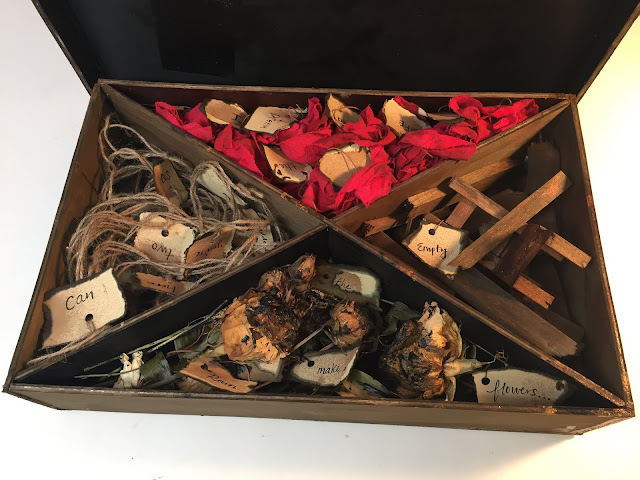Fluxus Box based off of the movie "Les Miserables" (2012). Materials: Plywood, Balsa wood, wood glue, nails, flowers, towel cloth, Rit fabric dye, string, paper, Walnut Ink set(Java, Terra Cotta, and Walnut), Micron pens, red and black acrylic paint, twine. 15"x10".
Artist Statement:
The fluxus box attempts to provide a narrative based off of the movie "Les Miserables" (2012). The exterior of the box is made from plywood and a distress stain made from a mixture of ink and water. The box is not sanded, and it has exposed seams and nails, along with chunks of glue and imperfections. The box is meant to be rough due to the war that occurs, but it is also uniform and seems like an old, distressed box, similar to one from the French Revolution. When the box opens, the black underside of the lid reveals four triangular sections which intersect in the middle. The triangles represent the love triangle in the story along with the intersecting storylines and generational connections among the characters. Each section is dense and cluttered, similar to how the movie itself has a lot of information and intricacies. The section with the bundle of twine represents family, specifically the relationship between Cosette and Valjean. It contains one long, continuous string, distressed and frayed yet strong and unbreakable similar to a bond between father and daughter. The long strand is made up of two strings kept together by knots. On each knot, there is a tag which is distressed using sprayed ink. The tags read "Suddenly you're here suddenly it starts can two anxious hearts beat as one?" This comes from the lyrics of the song that Valjean sings once he adopts Cosette after the death of her mother, Fantine. The string illustrates the words on them, and the viewer must unravel the string in order to read what it says.
In the section with the red pouches, this represents loss and sacrifice, specifically Fantine's sacrifice for Cosette. The bright red color was achieved through dyeing white fabric using Rit red fabric dye, and this red color represents the Red Light district that Fanzine was a part of, but it also suggests the intense love she had for her daughter, which is the reason why she sacrifices herself for her daughter. There are eight pouches stuffed in the section, and they are stained with red paint, ink, and water to make them look dirty and worn. There is one tag attached to each pouch, and they read "Now life has killed the dream I dreamed." This comes from the song that Fantine sings after she becomes a prostitute in order to make money for her daughter, "I Dreamed a Dream." There is a secret component to this section: If the viewer takes out the pouches, underneath them is a red cloth with more lyrics from the song, reading: "I dreamed a dream in times gone by, when hope was high and life worth living. I dreamed that love would never die... I dreamed that God would be forgiving... Then I was young and unafraid, and dreams were made and used and wasted. There was no ransom to be paid, no song unsung, no wine untasted." This was meant to be a note from Fantine herself, before she was tainted by the world and forced to sacrifice her life for her daughter. The pouches hold her sacrifices: her hair, teeth, body, and ultimately her soul. The pouches cover up her dreams, and they represent giving away pieces of ourselves for the ones we love.
In the section with the broken wood and furniture, this represents the barricades and the carnage of war. The wood is dark, splintered, and dirty with a reddish splatter to evoke blood and dirt. The tag "Empty" is on a chair, representing the song that Marius sings after coming back to see all of his friends had died in the war, "Empty Chairs at Empty Tables."
In the section with the dead flowers, this represents love, specifically the love triangle between Eponine, Marius, and Cosette. The dead/dried flowers are dipped in black paint, and they are cluttered and dense. Some flowers have the same tags on them, reading "Rain will make the flowers..." This represents Eponine's last words after she sacrificed herself by taking a bullet for Marius during the war. The dead flowers never grew, just as Eponine would never grow and blossom. Overall, the fluxes box attempts to create a somber narrative based off of the movie, "Les Miserable" (2012).
Three Forms of Research:
https://www.theartstory.org/movement-fluxus.htm
https://www.rollingstone.com/movies/movie-reviews/les-miserables-126579/
http://www.themusicallyrics.com/l/114-les-miserables-the-musical-songs-with-lyrics.html


























Comments
Post a Comment